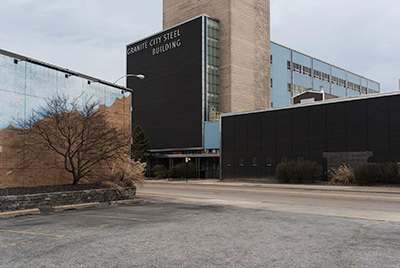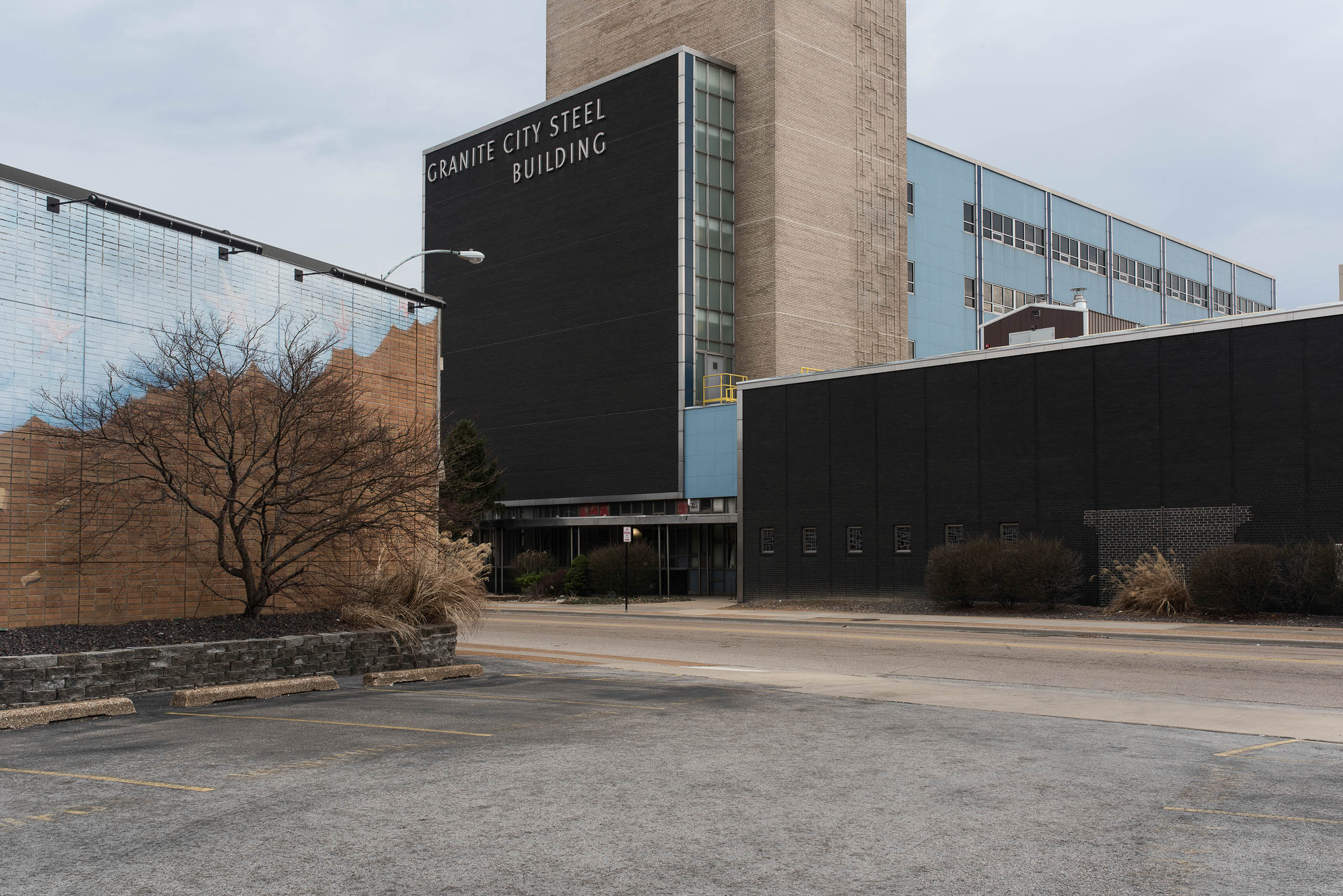



German immigrants Frederick G. and William F. Niedringhaus played a major role in St. Louis history by organizing the industrial city of Granite City, and a major role in American industry by pioneering the process of creating durable, affordable stamped and enameled metalware. The brothers had founded the St. Louis Stamping Company in 1866, and by 1871 had started construction of a still-extant factory in St. Louis where they deep stamped tin kitchenware, and built an adjacent rolling mill. The brothers saw limitations to enameled kitchenware and sought to improve its performance in American cooking, which utilized gas stoves made of iron. They came up with a process in which a sheet iron body was coated in highly vitrified glass in 1874, and patented granite ironware, sheet iron stamped and coated to resemble granite, in 1876.
In 1888 Frederick G. Niedringhaus successfully sought election to the US Congress as a Republican from the Eighth Congressional District of Missouri and served one term from March 1889 until March 1891. Niedringhaus had basically run for the office to secure steep tariffs against foreign tinplate, thereby securing the dominance of American companies like his own. Niedringhaus aided passage of the McKinley Tariff Act of 1890, which raised the duty on tinplate from $22.40 to $49.28 per ton. Two months after passage of the act, the Granite Iron Rolling Mills began to produce tinplate. By 1890 employment at the stamping plant rose to 900 workers. Upon his return to St. Louis, Frederick joined his brother in seeking a new site for the company’s operations. The first plan was to expand near the stamping plant, but with the Rolling Mills’ use of the Bessemer process for steel production, which required significant amounts of coal, two problems arose: St. Louis’ nuisance emission laws and the “arbitrary” fee on coal cross the Mississippi River set by Jay Gould on the Eads Bridge. The brothers cast their eyes eastward to the American Bottom, which had ample open land, proximity to coal, little impeding civic government, and railroad infrastructure supported by the Illinois General Assembly (Missouri was slow to use state funds on rail development even after the Civil War).
William Niedringhaus and his son George, whom many historians consider the driving force behind the land search, set out in August 1891 to survey lands just northeast and across the river from their stamping works in St. Louis. They visited the small town of Kinderhook (also known as Kinder) on the so-called Six-Mile Prairie in Madison County, Illinois. The improved road access led more farmers to the area, and eventually small towns like Kinderhook appeared on the prairie. Perhaps the biggest economic boon, however, came in 1856 when the Terre Haute and Alton Railroad built tracks south from Alton to East St. Louis across the land that would become Granite City. Without a rail bridge to St. Louis, this railroad terminated at Wiggins Ferry on the East St. Louis waterfront, from which train cars crossed into St. Louis via ferry. This situation changed little when the Eads Bridge was completed, due first to railroads’ not being able to obtain Missouri licenses needed to cross the river and later to monopoly control of the bridge. The Terre Haute and Alton line finally obtained a river crossing when the three-span-truss Merchant’s Bridge opened in May 1890.
Still, the area was very rural when the Niedringhaus family began to explore it. When they returned in 1892 to visit, they hired Kinderhook village schoolteacher Mark Henson as their land agent and scout. Henson obtained options on around 3,500 acres of land for the family, and they completed their purchase in 1893. They immediately set out to plan and build their new city that the brothers infused with progressive ideals, envisioning not a conventional company town but a real city where residents might be factory workers but would buy their own lots and raise their own homes as they saw fit. William had studied Pullman and thought that a more libertarian model would lead to a city that could be successful no matter what the St. Louis Stamping Company’s fate. The family’s deliberation over the name ultimately favored Granite City, the suggestion of patriarchs Frederick and William honoring the family’s product, over the less modest name of Niedringhaus offered by other family members.
By the end of 1893, the city had a plan designed by the city engineer of St. Louis. The design was inspired by that of Washington, DC, where Frederick Niedringhaus had just served in Congress. The brothers asked for an east-west thoroughfare diagonally crossing the city’s grid like Pennsylvania Avenue in the District of Columbia. On this street they would bestow family name. They also planted over 14,000 trees along the city’s new streets within two years of purchasing the land. Not all was progressive, though: blacks had to leave the town at sunset, and many black workers settled in nearby Lovejoy (now Brooklyn); the city charter forbade taverns; the Niedringhaus brothers made an estimated $4.8 million selling residential lots that had required $568,000 to purchase.
In 1895 the family hired noted St. Louis architect Frederick C. Bonsack to design new plants, one for the St. Louis Stamping Company and another for a steel rolling mill to supply the stamping works. The new plant for St. Louis Stamping comprised 30 acres and produced graniteware and galvanized ware (among other products) for pots and pans, foot baths, and gold mining pans. Bonsack designed a wonderful four-story office building in the Romanesque style, featuring a wide, Richardsonian arched entrance under a small tower. Within seven years, 1,200 people would be employed there. By the end of the year, the family opened the Granite City Steel plant that today is part of US Steel. The plant contained two 22-ton, open-hearth furnaces and four mills capable of producing 20,000 gross tons of finished product annually. This facility was needed to supply rolled steel sheets to the stamping company. Originally the plant only made the sheets but in 1905 diversified its output. By 1908 the plant made 4 tons of bar steel and tinplate daily, employed 2,000 men, and covered 15 acres. The St. Louis plant would remain active until 1912, when the family closed it.
In 1899 the Niedringhaus family’s growing national reputation enticed them to rename their stamping company the National Enamelling and Stamping Company, or NESCO. NESCO kept its main office in downtown St. Louis, and founding brothers Frederick and William never moved to the city, instead residing in fashionable West End mansions. By the middle of the first decade of the twentieth century, about ten years after Granite City was founded, the stamping works covered 1.25 million square feet on 75 acres of land and employed 4,000 persons. With its hundreds of jobs for skilled and unskilled laborers, the city became a magnet for immigrants. The first wave of immigration came to work at the NESCO plant and steel mills, and largely consisted of Welsh and English immigrants. Many Polish families migrated from St. Louis around 1900, followed by Slovaks, Greeks, Croatians, and Serbs who largely worked at the Commonwealth and American steel foundries. Later waves of immigration included Macedonians, Bulgarians, Romanians, Russians, and Lithuanians. Finally, Mexicans arrived during World War I to take the place of conscripted laborers.
Excerpted from: Michael R. Allen, "Intangible Heritage on the American Bottom"
Intangible Heritage on the American Bottom
Listening to the American Bottom